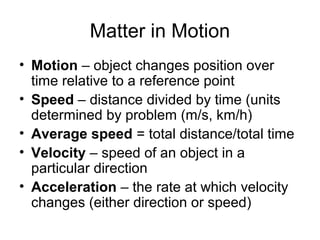Speed, time, distance
•Als PPT, PDF herunterladen•
1 gefällt mir•5,185 views
Motion refers to an object changing position over time relative to a reference point. Speed is the distance an object travels divided by the time taken and is measured in meters per second or kilometers per hour. Average speed is the total distance divided by the total time. Velocity also includes direction of motion. Acceleration is the rate at which velocity changes. A force is a push or pull measured in newtons, but a force being applied does not necessarily mean motion will occur. The net force is the combination of all acting forces on an object. Gravity is the force of attraction between objects due to their mass. Weight is a measure of the gravitational force on an object that depends on its mass and location.
Melden
Teilen
Melden
Teilen

Empfohlen
Weitere ähnliche Inhalte
Was ist angesagt?
Was ist angesagt? (20)
Andere mochten auch
Andere mochten auch (16)
Ähnlich wie Speed, time, distance
Ähnlich wie Speed, time, distance (20)
Mehr von tracyconover
Mehr von tracyconover (20)
Speed, time, distance
- 1. Matter in Motion • Motion – object changes position over time relative to a reference point • Speed – distance divided by time (units determined by problem (m/s, km/h) • Average speed = total distance/total time • Velocity – speed of an object in a particular direction • Acceleration – the rate at which velocity changes (either direction or speed)
- 2. • Force – a push or pull (unit is newton N) • Force applied does not mean motion will occur • Net force – combination of all forces acting on an object • Force in the same direction is always added, force in opposite directions is always subtracted
- 3. • Net force that equals 0 is balanced ( and no motion will take place) otherwise the net force is unbalanced and there will be motion • Friction – force that opposes motion • Static – not moving • Gravity – force of attraction between two objects due to their mass
- 4. • Law of universal gravitation – relationship between gravitational force, mass and distance (Newton’s 3 laws of motion) • Gravitational force increase as mass increases and gravitational force decreases when distance increases • Weight – measure of the force of gravity on an object due to mass, changes with location to source of gravity
- 5. • Weight units are N (100 g = 1 N) NOT POUNDS • Mass – amount of matter in an object (units kg) • Objects have weight only if there is a source of gravity present, since all matter has mass, all objects will experience the force of gravity depending on the mass of the object and the distance from the source of gravity • Formulas: – s =d / t (speed = distance divided by time) – d=s x t (distance = speed x time) – t=d / s (time = distance divided by speed)
- 6. • Weight units are N (100 g = 1 N) NOT POUNDS • Mass – amount of matter in an object (units kg) • Objects have weight only if there is a source of gravity present, since all matter has mass, all objects will experience the force of gravity depending on the mass of the object and the distance from the source of gravity • Formulas: – s =d / t (speed = distance divided by time) – d=s x t (distance = speed x time) – t=d / s (time = distance divided by speed)